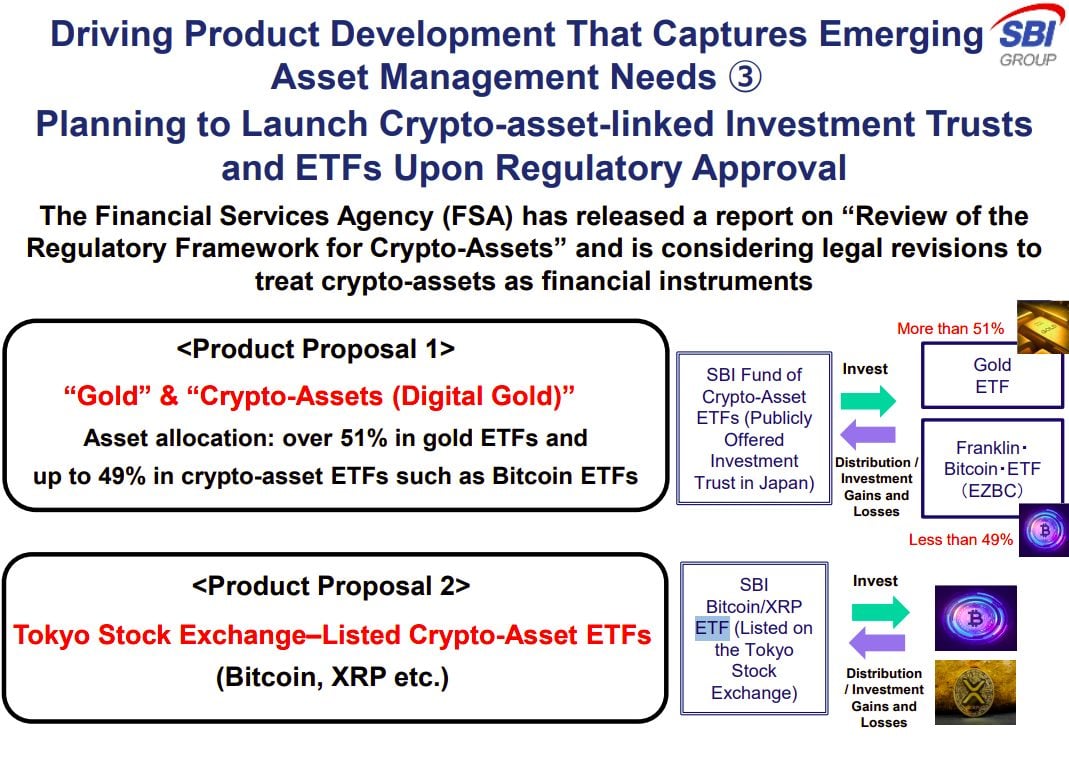TradFi giant SBI Holdings floats first-ever Bitcoin, XRP ETF launch in Japan
Key Takeaways
- SBI Holdings expects to launch Japan's first crypto ETFs, focusing on XRP, Bitcoin, and a blended 'Digital Gold' ETF.
- The crypto ETF will provide investors with direct exposure to both XRP and Bitcoin via traditional financial instruments.
SBI Holdings, Japan’s financial conglomerate with active operations in banking, securities, asset management, and fintech, has floated plans to introduce Bitcoin and XRP exchange-traded funds (ETFs) on the Tokyo Stock Exchange, subject to forthcoming regulatory changes.
In its latest financial results presentation , SBI has outlined two proposals designed to capture the growing demand for digital asset management and take advantage of potential legal revisions currently under review by Japan’s Financial Services Agency (FSA).
The first is a hybrid investment trust combining traditional gold ETFs with crypto-asset ETFs like Franklin’s Bitcoin ETF (EZBC), with up to 49% allocated to crypto.

The second is a crypto ETF proposed for listing on the Tokyo Stock Exchange. The SBI Bitcoin/XRP ETF is cited as an example, signaling readiness to launch pending regulatory approval. These ETFs would trade like any listed security, targeting wider retail and institutional access.
Earlier this year, the FSA released a discussion paper on revising the crypto regulatory framework, proposing to reclassify crypto assets as financial instruments, balancing innovation with investor protection and closing regulatory gaps.
The proposal would pave the way for the legalization and regulation of crypto ETFs, meaning these products could be officially offered in Japan under strict regulatory oversight comparable to traditional securities.
SBI’s move could increase the institutional adoption of XRP and other digital assets in Japan’s regulated investment market. Japan has maintained a relatively structured approach to crypto regulation compared to other major economies.
SBI Holdings has shown interest in crypto assets and blockchain technology through various business ventures and partnerships.
In April 2024, Franklin Templeton and SBI Holdings entered into a partnership to form a new crypto ETF management company in Japan. The parties have signed a Memorandum of Understanding to provide young investors with greater access to diversified investment vehicles, including crypto-based ETFs.
Disclaimer: The content of this article solely reflects the author's opinion and does not represent the platform in any capacity. This article is not intended to serve as a reference for making investment decisions.
You may also like
2025 TGE Survival Ranking: Who Will Rise to the Top and Who Will Fall? Complete Grading of 30+ New Tokens, AVICI Dominates S+
The article analyzes the TGE performance of multiple blockchain projects, evaluating project performance using three dimensions: current price versus all-time high, time span, and liquidity-to-market cap ratio. Projects are then categorized into five grades: S, A, B, C, and D. Summary generated by Mars AI This summary was generated by the Mars AI model, and the accuracy and completeness of its content are still being iteratively updated.

Mars Finance | "Machi" increases long positions, profits exceed 10 million dollars, whale shorts 1,000 BTC
Russian households have invested 3.7 billion rubles in cryptocurrency derivatives, mainly dominated by a few large players. INTERPOL has listed cryptocurrency fraud as a global threat. Malicious Chrome extensions are stealing Solana funds. The UK has proposed new tax regulations for DeFi. Bitcoin surpasses $91,000. Summary generated by Mars AI. The accuracy and completeness of this summary are still being iteratively updated by the Mars AI model.

How much is ETH really worth? Hashed provides 10 different valuation methods in one go
After taking a weighted average, the fair price of ETH exceeds $4,700.

Dragonfly partner: Crypto has fallen into financial cynicism, and those valuing public blockchains with PE ratios have already lost
People tend to overestimate what can happen in two years, but underestimate what can happen in ten years.
